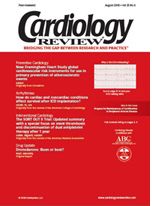Anne Taylor, MD, comments on A-HeFT
Cardiology Review (CR) recently spoke with Anne L. Taylor, MD, professor and associate dean at the University of Minnesota School of Medicine and lead investigator of the African-American Heart Failure Trial (A-HeFT).1
CR: The A-HeFT trial showed a 43% improvement in survival for heart failure patients, but it was also the first clinical trial conducted in an all African American population. What do you believe will be the impact of this trial on future clinical trials involving African Americans?
Dr. Taylor: I think this is going to tell us how critically important it is to have diversity in clinical trials—to have both women and minorities included in sufficient numbers so that we can do subgroup analyses to show whether responses are the same or different. There will not always be population differences by ethnicity; differences may be by gender, by environmental factors, or by lifestyle factors, but we need to look at populations so that we can understand what’s different and what’s the same.
The FDA makes their labeling decisions about products based on data from controlled clinical trials, and the A-HeFT data were strong. The trial certainly dem-onstrated a huge benefit in African Americans, so I think the big question is whether there will be other groups that will benefit from this fixed-dose combination (isosorbide dinitrate and hydralazine). We also have to figure out the mechanism by which the drug works, and how we would identify responsiveness in other groups. We have data from the Vasodilator-Heart Failure Trial (V-HeFT)2 that really showed a difference in the response between African Americans and white subjects (with isosorbide dinitrate/hydralazine versus prazosin) and that was one of the reasons for conducting this trial in the African American population. V-HeFT was based on very small numbers, and it was done 25 years ago, so those patients were not on contemporary medications. So it was extremely important to do this trial to confirm that suggestion of a benefit and we did confirm it. I think that ultimately we will find other populations that will benefit from this combination, which has been used for many years in heart failure patients. The Heart Failure Society Guidelines, for example, recommend the use of this combination for patients who have kidney disease. What I think it will do now is shift the recommendations to say that this is especially effective in African Americans but it may be effective in other subsets of patients.
CR: Why was this trial so important for the Association of Black Cardiologists (ABC)?
Dr. Taylor: ABC has been in existence for more than 30 years and has focused on the higher cardiovascular risk burden in the African American population. So this trial was important to ABC simply because they have been invested in reducing the disparities in health care outcomes and the cardiovascular disparities in particular, between African Americans and whites. African Americans die at a more frequent rate and at younger ages from cardiovascular disease, whether it is from heart failure or coronary disease. And so this organization has been focused on reducing that risk, to bring the risk for African Americans in line with other groups, thus reducing disparities but also reducing risk overall.
CR: Did you present any new data from A-HeFT when you spoke at
the recent ABC Booker Symposium; and what was the key take-home message that you wanted to convey to primary care practitioners (PCPs) through that presentation?
Dr. Taylor: I presented an additional subgroup analysis and some other subsequent analyses based on the A-HeFT data. Because a larger percentage of heart failure patients are cared for by PCPs than by heart failure specialists, we have to get the word out to PCPs about the A-HeFT trial results. Heart failure specialists tend to see patients with very advanced disease who need transplantation or artificial support systems for the heart, but PCPs take care of “run-of-the-mill” heart failure, and so it’s very important that this message get out to them. I hope they took away the evidence for an evolution in the management of heart failure in African Americans. Based on A-HeFT, African Americans with heart failure who are being treated with other standard medications should have this combination drug added. It proved to have a huge benefit. My presentation reviewed the data and how the drug was used in the clinical trial population because that’s how it should be applied in the general population.
One thing people don’t recognize about heart failure is what a terrible disease it is. We can’t cure heart failure; for the majority of patients we can only slow its progress, and quality of life is miserable. Patients can’t exercise or enjoy the things that people do with families. Their physical capacities are often very limited. Depression is extremely common. People spend a lot of time in hospitals, and 5-year mortality is higher than for many cancers. So because this combination drug added to standard therapy improved quality of life and reduced the risk of dying over the time of the trial, as well as the hospitalization rate, it’s quite a stunning result. So now that we have the clinical trial evidence, we have to disseminate it so that it gets applied.
CR: Where do we go from here in the treatment of heart failure?
Dr. Taylor: We need to understand precisely the mechanism of action of this drug combination. We think we know how it works, but this trial showed effectiveness; it did not prove mechanism of action. So there’s lots of future research that these findings will stimulate. I believe that one other thing this trial did was put back on the table in a very real way how we address differences among populations: how we study them, how we identify those populations. And I think that that has been a very intense, but a very healthy discussion.
